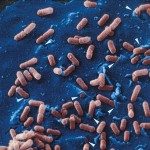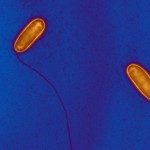Lien vers Pubmed [PMID] – 16415595
J. Mol. Microbiol. Biotechnol. 2005;9(3-4):224-34
Listeria monocytogenes PrfA, a transcription activator for several virulence genes, including the hemolysin-encoding hly, is inhibited by rapidly metabolizable carbon sources (glucose, fructose, etc.). This inhibition is not mediated via the major carbon catabolite repression mechanism of gram-positive bacteria, since inactivation of the catabolite control protein A (CcpA) did not prevent the repression of virulence genes by the above sugars. In order to test whether the catabolite co-repressor P-Ser-HPr might be involved in PrfA regulation, we used a Bacillus subtilis strain (BUG1199) containing L. monocytogenes prfA under control of pspac and the lacZ reporter gene fused to the PrfA-activated hly promoter. Formation of P-Ser-HPr requires the bifunctional HPr kinase/phosphorylase (HprK/P), which, depending on the concentration of certain metabolites, either phosphorylates HPr at Ser-46 or dephosphorylates P-Ser-HPr. The hprKV267F allele codes for an HprK/P leading to the accumulation of P-Ser-HPr, since it has normal kinase, but almost no phosphorylase activity. Interestingly, introducing hprKV267F into BUG1199 strongly inhibited transcription activation by PrfA. Preventing the accumulation of P-Ser-HPr in the hprKV267F mutant by replacing Ser-46 in HPr with an alanine restored PrfA activity, while ccpA inactivation had no effect. Interestingly, disruption of ccpA in the hprK wild-type strain BUG1199 also led to inhibition of PrfA. The lowered lacZ expression in the ccpA strain is probably also due to elevated amounts of P-Ser-HPr, since it disappeared when Ser-46 in HPr was replaced with an alanine. To carry out its catalytic function in sugar transport, HPr of the phosphotransferase system (PTS) is also phosphorylated by phosphoenolpyruvate and enzyme I at His-15. However, P-Ser-HPr is only very slowly phosphorylated by enzyme I, which probably accounts for PrfA inhibition. In agreement with this concept, disruption of the enzyme I- or HPr-encoding genes also strongly inhibited PrfA activity. PrfA activity therefore seems to depend on a fully functional PTS phosphorylation cascade.



